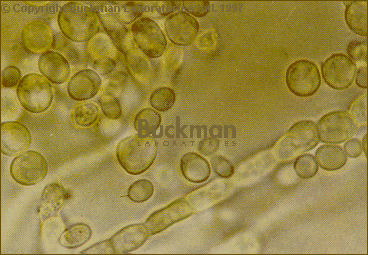|
Fungi are living organisms that are classified into a separate kingdom, one of five making up the Kingdoms of Organisms. They have a closer resemblance and relationship to animals than plants, but are unique life forms. Fungi are microscopic in size, and are therefore somewhat hidden in the realm of microbiology. They are a mycelium (or mass) comprised of tiny filamentous threads known as hyphae. The mycelium is usually found hidden in a food source in the soil, wood, or other. Fungi construct their cell walls out of chitin, a boney or horny polysaccharide that is found in the crust (or shell) of insects, crustaceans, and other arthropods. Fungi feed by absorbing nutrients from organic materials in the soil, or other similar sources. Their food must be digested prior to absorption, as they have no internal means to digest. The hyphae in fungi secrete acids and enzymes that breakdown organic matter into simple molecules that can be easily absorbed. They have evolved to use different sources of food. Some survive by living on dead organic tissues and residues, a source known as substrate. Others survive on a parasitic basis, feeding on living organisms for food, a source known as a host. These type are responsible for diseases in plants and animals. The part of a fungus that is visible to the eye is essentially the fruit of the organism, not the organism itself.
Fungi are essential to plant growth, as part of the balanced mix of the microbial community in soils. Mycorrhizal fungi live as partners with plants, providing mineral nutrients in exchange for carbohydrates or other chemicals that fungi cannot manufacture. This can only be accomplished through symbiotic partnerships, of which there are three types. A parasitic relationship provides benefit to the fungus, but harms the host plant. A mutual symbiotic partnership benefits both the fungus and the host plant. mix of the microbial community in soils. Mycorrhizal fungi live as partners with plants, providing mineral nutrients in exchange for carbohydrates or other chemicals that fungi cannot manufacture. This can only be accomplished through symbiotic partnerships, of which there are three types. A parasitic relationship provides benefit to the fungus, but harms the host plant. A mutual symbiotic partnership benefits both the fungus and the host plant.
|
Fungi - Filamentatious Yeast Buckman Laboratories 2007
|
A neutral symbiotic relationship benefits the fungus, and has no effect on the host plant.
Lichens used to be thought of as plantae organism, but it is now known that they are a result of a mutual symbiotic relationship between fungi and algae or cyanobacteria. The hyphae of the fungus surround the cells of the algae providing an element of protection. As photosynthetic organisms, the algae and cyanobacteria produce their own foods of which the fungus is able to extract vitamins necessary for its survival. The protection provided by the fungus helps the algae preserve water, thereby extending its survivability during drought. This successful partnership has allowed lichens to colonize many different habitats, but is especially successful in soils that are constantly tilled or ‘disturbed’. Some common lichens in the 13,000 to 18,000 species are Ascomycetes, Actinomycetes, and Basidiomycetes. Lichens are important in making soil, attaching to stones and rock, and through the release of acids, they break down the materials releasing minerals.
Fungal products are used daily by people without their knowing about it. People eat mushrooms of all types, as a raw food, or in packaged mixtures in sauces, soups, etc. Yeasts are derived from fungi, and are used in making bread, wine, beer, and solvents. Many pharmaceuticals are derived from various strains of fungi to fight bacterial and other infections. Fungi are also used to produce flavorings for cooking, vitamins, and enzymes.
|



 mix of the microbial community in soils. Mycorrhizal fungi live as partners with plants, providing mineral nutrients in exchange for carbohydrates or other chemicals that fungi cannot manufacture. This can only be accomplished through symbiotic partnerships, of which there are three types. A parasitic relationship provides benefit to the fungus, but harms the host plant. A mutual symbiotic partnership benefits both the fungus and the host plant.
mix of the microbial community in soils. Mycorrhizal fungi live as partners with plants, providing mineral nutrients in exchange for carbohydrates or other chemicals that fungi cannot manufacture. This can only be accomplished through symbiotic partnerships, of which there are three types. A parasitic relationship provides benefit to the fungus, but harms the host plant. A mutual symbiotic partnership benefits both the fungus and the host plant.